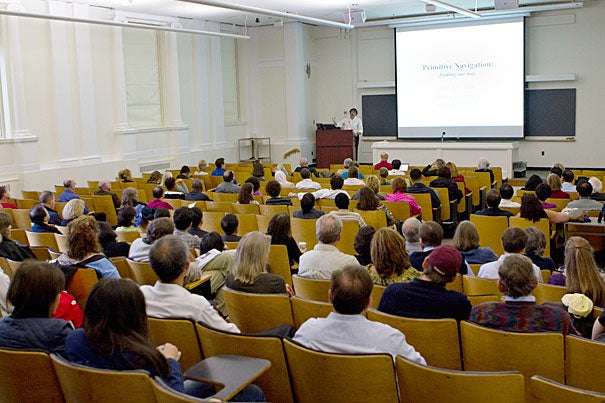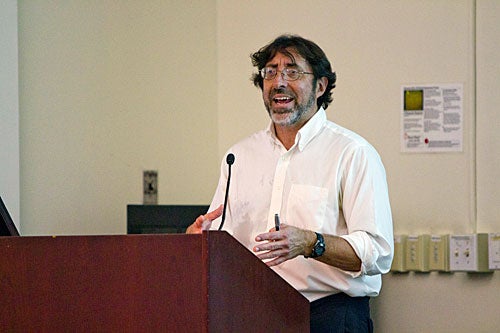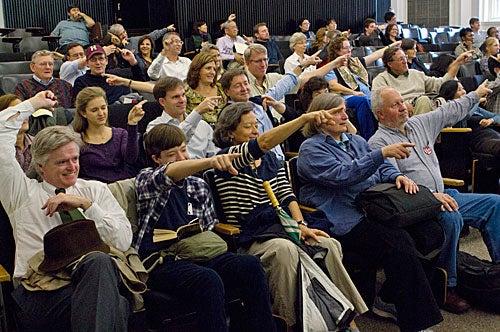
Freshman parents turned out in droves to hear Donner Professor of Science John Huth’s lecture on his course “Primitive Navigation.” Huth told parents that the goals of the course were not only to teach students practical skills that could one day save their lives, but also to help open up their senses to the natural world.
Photos by Meghan Dhaliwal/Harvard Staff Photographer
Know your gnomon
Presentation gives advanced look at primitive navigation
The story of Donner Professor of Science John Huth’s interest in primitive navigation techniques began with a body. Two bodies, actually.
On his way to do some kayaking off Cape Cod a couple of summers ago, he was stopped by the harbormaster, who told him that two young women had gone missing the day before. They too had gone out in kayaks — neither with a compass — and told their boyfriends that they would return in only 15 minutes. After an hour with no sign of the women, authorities began a search and rescue operation. The next day, one body was found. The other was never recovered.
“These young ladies were 19 and 20 years old, college students,” he said. “I actually have two students in college myself. If you read it in the newspaper, you might say, ‘What a shame. That’s horrible,’ and then turn the page. But having been out there at the same time, in the same conditions, it became harder for me to take.”
In response to the tragedy, Huth, a physics professor who can often be found working at the Large Hadron Collider at the CERN complex in Switzerland, developed his “Primitive Navigation” class, first as a Freshman Seminar, then as a General Education course. The professor gave the families of first-year students a one-hour overview of the course Oct. 14 as part of the annual Freshman Parents Weekend program of lectures, tours, and open houses.
Huth told parents that the goals of the course were not only to teach students practical skills that could one day save their lives, but also to help open up their senses to the natural world.
“The people around you are relatively closed down, because we aren’t trained to notice [the natural environment],” Huth told his students. “And yet there’s a huge amount of information that’s right at the tips of our fingers that we’re tuning out.”

To get the course material to stick with students, Huth designed “Primitive Navigation” as a combination of classroom learning and hands-on outdoor activities. In class, he taught students that common measures of distance grew out of human experience. The word “mile,” for instance, comes from the Latin “mille pacem,” or “1,000 paces.” Outside of class, Huth had students find their bearings — literally — by getting them to measure their steps, to pay attention to how fast they walked, and to understand how the movement of the stars was related to the change of seasons.
“We took the students to the roof of the Science Center and had them identify some major stars,” he said. “They watched the movement over the course of an hour to try and get that motion ingrained.”
Huth explained some other primitive navigation technologies to the crowd. Imagine that you’re in the middle of the woods. Your iPhone is out of juice, so there’s no global positioning technology to rely on. The terrain is unfamiliar. There’s not a soul in sight to give you directions. But if no man can help you find your way, a gnomon could. That’s because a gnomon is a stick that casts a shadow made by the sun, which makes it possible to create a working compass.
For the course’s final project, Huth had students work in teams. The members of one — the Swiftness Collective — decided to see if they could actually navigate the Harvard campus using the type of sun compass that the Vikings might have had to get around hundreds of years ago. First, the students camped out on the banks of the Charles River on a cold, sunny day to create the instrument, marking off the shadows cast by the gnomon every 15 minutes from sunrise to sunset. The students then used the sun compass to orient themselves and to set the course for several campus landmarks: the Weeks Footbridge, Weld Boathouse, Blackstone Steam Plant, and the Memorial Church. Their bearings were just as good as a magnetic compass, and only a little askew from Google Earth data.
When the talk was finished, Rosella Stow of Minneapolis said that she was pleased to know that her daughter, Margaret Nietfeld ’15, could find courses at Harvard that melded the intellectual with the practical.
“I thought it was really interesting,” she said. “He’s teaching people what many generations of the past could learn from what was around them, so that his students can say, ‘What’s here to help me get my bearings and go in the right direction?’”
Share this article





